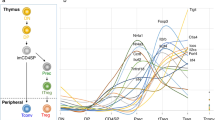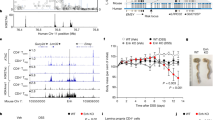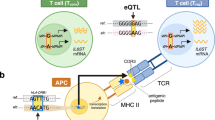Abstract
IL-2, a T-cell growth and differentiation factor, plays an important role in immune homeostasis. Previously, we identified IL2 as a candidate for Aod2, a quantitative trait locus (QTL) controlling susceptibility to autoimmune ovarian dysgenesis (AOD) induced by day 3 neonatal thymectomy. Here, we report the identification of single-nucleotide polymorphisms (SNPs) in a region upstream of the minimal IL2 promoter (−2.8 kb to −300 bp), which distinguish AOD-susceptible A/J and AOD-resistant C57BL/6J (B6/J) mice. Six of the SNPs (−1010 C → T, −962 C → T, −926/−925 ΔΔ → AC, −921 T → C, −914 T → C and −674 G → A) contribute to the enhanced transcriptional activity of the extended B6/J promoter relative to A/J. Importantly, the −1010 SNP resides within a canonical AP-1-binding motif with the C → T transition at this site abrogating AP-1 binding. Moreover, these SNPs segregate with differential production of IL-2 by CD4+ T cells as well as susceptibility alleles at Idd3 and Eae3, QTL controlling insulin-dependent diabetes mellitus and experimental allergic encephalomyelitis. These are the first SNPs identified within the extended murine IL2 promoter that control differential IL-2 transcription in CD4+ T cells, and, as such, they are not only candidates for Aod2, but are also candidates for a shared autoimmune disease-susceptibility locus underlying Idd3 and Eae3.
This is a preview of subscription content, access via your institution
Access options
Subscribe to this journal
Receive 6 digital issues and online access to articles
$119.00 per year
only $19.83 per issue
Buy this article
- Purchase on Springer Link
- Instant access to full article PDF
Prices may be subject to local taxes which are calculated during checkout




Similar content being viewed by others
Accession codes
References
de Faucal P, Godard A, Peyrat MA, Moreau JF, Soulillou JP . Impaired IL2 production by lymphocytes of patients with systemic lupus erythematosus. Ann Immunol 1984; 135D: 161–172.
Katsiari CG, Tsokos GC . Transcriptional repression of interleukin-2 in human systemic lupus erythematosus. Autoimmun Rev 2006; 5: 118–121.
Sadlack B, Merz H, Schorle H, Schimpl A, Feller AC, Horak I . Ulcerative colitis-like disease in mice with a disrupted interleukin-2 gene. Cell 1993; 75: 253–261.
Sadlack B, Lohler J, Schorle H, Klebb G, Haber H, Sickel E et al. Generalized autoimmune disease in interleukin-2-deficient mice is triggered by an uncontrolled activation and proliferation of CD4+ T cells. Eur J Immunol 1995; 25: 3053–3059.
Suzuki H, Kundig TM, Furlonger C, Wakeham A, Timms E, Matsuyama T et al. Deregulated T cell activation and autoimmunity in mice lacking interleukin-2 receptor beta. Science 1995; 268: 1472–1476.
Setoguchi R, Hori S, Takahashi T, Sakaguchi S . Homeostatic maintenance of natural Foxp3(+) CD25(+) CD4(+) regulatory T cells by interleukin (IL)-2 and induction of autoimmune disease by IL-2 neutralization. J Exp Med 2005; 201: 723–735.
Tung KS, Smith S, Teuscher C, Cook C, Anderson RE . Murine autoimmune oophoritis, epididymoorchitis, and gastritis induced by day 3 thymectomy. Immunopathology. Am J Pathol 1987; 126: 293–302.
Elliott EA, Flavell RA . Transgenic mice expressing constitutive levels of IL-2 in islet beta cells develop diabetes. Int Immunol 1994; 6: 1629–1637.
Allison J, Malcolm L, Chosich N, Miller JF . Inflammation but not autoimmunity occurs in transgenic mice expressing constitutive levels of interleukin-2 in islet beta cells. Eur J Immunol 1992; 22: 1115–1121.
von Herrath MG, Allison J, Miller JF, Oldstone MB . Focal expression of interleukin-2 does not break unresponsiveness to ‘self’ (viral) antigen expressed in beta cells but enhances development of autoimmune disease (diabetes) after initiation of an anti-self immune response. J Clin Invest 1995; 95: 477–485.
Asano M, Toda M, Sakaguchi N, Sakaguchi S . Autoimmune disease as a consequence of developmental abnormality of a T cell subpopulation. J Exp Med 1996; 184: 387–396.
Thornton AM, Donovan EE, Piccirillo CA, Shevach EM . IL-2 is critically required for the in vitro activation of CD4+CD25+ T cell suppressor function. J Immunol 2004; 172: 6519–6523.
Fontenot JD, Rasmussen JP, Gavin MA, Rudensky AY . A function for interleukin 2 in Foxp3-expressing regulatory T cells. Nat Immunol 2005; 6: 1142–1151.
Bayer AL, Yu A, Adeegbe D, Malek TR . Essential role for interleukin-2 for CD4(+)CD25(+) T regulatory cell development during the neonatal period. J Exp Med 2005; 201: 769–777.
Samy ET, Parker LA, Sharp CP, Tung KS . Continuous control of autoimmune disease by antigen-dependent polyclonal CD4+CD25+ regulatory T cells in the regional lymph node. J Exp Med 2005; 202: 771–781.
Matesanz F, Fedetz M, Collado-Romero M, Fernandez O, Guerrero M, Delgado C et al. Allelic expression and interleukin-2 polymorphisms in multiple sclerosis. J Neuroimmunol 2001; 119: 101–105.
van Heel DA, Franke L, Hunt KA, Gwilliam R, Zhernakova A, Inouye M et al. A genome-wide association study for celiac disease identifies risk variants in the region harboring IL2 and IL21. Nat Genet 2007; 39: 827–829.
Lowe CE, Cooper JD, Brusko T, Walker NM, Smyth DJ, Bailey R et al. Large-scale genetic fine mapping and genotype–phenotype associations implicate polymorphism in the IL2RA region in type 1 diabetes. Nat Genet 2007; 9: 1074–1082.
Mattuzzi S, Barbi S, Carletto A, Ravagnani B, Moore PS, Bambara LM et al. Association of polymorphisms in the IL1B and IL2 genes with susceptibility and severity of systemic sclerosis. J Rheumatol 2007; 34: 997–1004.
International Multiple Sclerosis Genetics Consortium. Risk alleles for multiple sclerosis identified by a genomewide study. N Engl J Med 2007; 357: 851–862.
Chesnut K, She JX, Cheng I, Muralidharan K, Wakeland EK . Characterizations of candidate genes for IDD susceptibility from the diabetes-prone NOD mouse strain. Mamm Genome 1993; 4: 549–554.
Podolin PL, Wilusz MB, Cubbon RM, Pajvani U, Lord CJ, Todd JA et al. Differential glycosylation of interleukin 2, the molecular basis for the NOD Idd3 type 1 diabetes gene? Cytokine 2000; 12: 477–482.
Encinas JA, Wicker LS, Peterson LB, Mukasa A, Teuscher C, Sobel R et al. QTL influencing autoimmune diabetes and encephalomyelitis map to a 0.15-cM region containing Il2. Nat Genet 1999; 21: 158–160.
Yamanouchi J, Rainbow D, Serra P, Howlett S, Hunter K, Garner VE et al. Interleukin-2 gene variation impairs regulatory T cell function and causes autoimmunity. Nat Genet 2007; 39: 329–337.
Teuscher C, Wardell BB, Lunceford JK, Michael SD, Tung KS . Aod2, the locus controlling development of atrophy in neonatal thymectomy-induced autoimmune ovarian dysgenesis, co-localizes with Il2, Fgfb, and Idd3. J Exp Med 1996; 183: 631–637.
Roper RJ, Ma RZ, Biggins JE, Butterfield RJ, Michael SD, Tung KS et al. Interacting quantitative trait loci control loss of peripheral tolerance and susceptibility to autoimmune ovarian dysgenesis after day 3 thymectomy in mice. J Immunol 2002; 169: 1640–1646.
Teuscher C . Experimental allergic orchitis in mice. II. Association of disease susceptibility with the locus controlling Bordetella pertussis-induced sensitivity to histamine. Immunogenetics 1985; 22: 417–425.
Sudweeks JD, Todd JA, Blankenhorn EP, Wardell BB, Woodward SR, Meeker ND et al. Locus controlling Bordetella pertussis-induced histamine sensitization (Bphs), an autoimmune disease-susceptibility gene, maps distal to T-cell receptor beta-chain gene on mouse chromosome 6. Proc Natl Acad Sci USA 1993; 90: 3700–3704.
Meeker ND, Stafford AN, Lunceford JK, Avner P, Ma RZ, Teuscher C . Physical mapping of the autoimmune disease susceptibility locus, Bphs: co-localization with a cluster of genes from the TNF receptor superfamily on mouse chromosome 6. Mamm Genome 1999; 10: 858–863.
Ma RZ, Gao J, Meeker ND, Fillmore PD, Tung KS, Watanabe T et al. Identification of Bphs, an autoimmune disease locus, as histamine receptor H1. Science 2002; 297: 620–623.
Zhernakova A, Alizadeh BZ, Bevova M, van Leeuwen MA, Coenen MJH, Franke B et al. Novel association in chromosome 4q27 region with rheumatoid arthritis and confirmation of type 1 diabete point to a general risk locus for autoimmune disease. Am J Hum Genet 2007; 81: 1284–1288.
Roper RJ, McAllister RD, Biggins JE, Michael SD, Min SH, Tung KS et al. Aod1 controlling day 3 thymectomy-induced autoimmune ovarian dysgenesis in mice encompasses two linked quantitative trait loci with opposing allelic effects on disease susceptibility. J Immunol 2003; 170: 5886–5891.
Powell JD, Lerner CG, Ewoldt GR, Schwartz RH . The −180 site of the IL-2 promoter is the target of CREB/CREM binding in T cell anergy. J Immunol 1999; 163: 6631–6639.
Solomou EE, Juang YT, Gourley MF, Kammer GM, Tsokos GC . Molecular basis of deficient IL-2 production in T cells from patients with systemic lupus erythematosus. J Immunol 2001; 166: 4216–4222.
Rincon M, Flavell RA . Regulation of AP-1 and NFAT transcription factors during thymic selection of T cells. Mol Cell Biol 1996; 16: 1074–1084.
Davis RJ . Signal transduction by the JNK group of MAP kinases. Cell 2000; 103: 239–252.
Diehl S, Chow CW, Weiss L, Palmetshofer A, Twardzik T, Rounds L et al. Induction of NFATc2 expression by interleukin 6 promotes T helper type 2 differentiation. J Exp Med 2002; 196: 39–49.
Rincon M, Flavell RA . AP-1 transcriptional activity requires both T-cell receptor-mediated and co-stimulatory signals in primary T lymphocytes. EMBO J 1994; 13: 4370–4381.
Tugores A, Alonso MA, Sanchez-Madrid F, de Landazuri MO . Human T cell activation through the activation-inducer molecule/CD69 enhances the activity of transcription factor AP-1. J Immunol 1992; 148: 2300–2306.
Acknowledgements
This work was supported by NIH Grants AI041747, AI058052, AI045666, NS036526 and AI051454.
Author information
Authors and Affiliations
Corresponding author
Additional information
Conflict of interest
The authors have declared that no conflict of interest exists.
Supplementary Information accompanies the paper on Genes and Immunity website (http://www.nature.com/gene)
Supplementary information
Rights and permissions
About this article
Cite this article
del Rio, R., Noubade, R., Subramanian, M. et al. SNPs upstream of the minimal promoter control IL-2 expression and are candidates for the autoimmune disease-susceptibility locus Aod2/Idd3/Eae3. Genes Immun 9, 115–121 (2008). https://doi.org/10.1038/sj.gene.6364455
Received:
Revised:
Accepted:
Published:
Issue Date:
DOI: https://doi.org/10.1038/sj.gene.6364455



